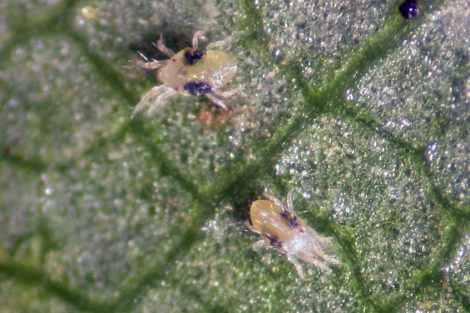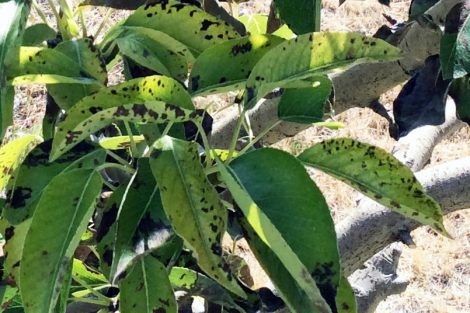In this Issue
- Apple and Pear: updated dates for codling moth egg hatch; fire blight tree death; San Jose scale second generation coming up; continue to watch for woolly apple aphid; calcium for bitter pit
- Cherry, Peach/Nectarine: cherry post-harvest activities for fruit fly and powdery mildew; peach twig borer second generation update
- All Fruits: spider mite feeding is increasing; cat-facing injury
- Production Activities: summer pruning; foliar nutrient testing
- Small Fruits: rose stem girdler damage; grape leafhoppers active
APPLE, PEAR
Codling Moth
provide continuous protection of fruit until Sept. 15

View a pdf of the spray timing table. Be sure to read the instructions at the top of the page, for how to read the table. (Note: some dates are in italics because they are past dates.)
Most areas are approaching the period of greatest egg hatch for the second generation. However, at time of year, egg hatch is almost continuous. Therefore, it is important to maintain protection of fruits regularly until September 15, or harvest (whichever is earlier). (Mid-September is the time when the eggs stop hatching due to shorter day-lengths.)
Fire Blight Rootstock Infection
trees die suddenly

This year, fire blight due to blossom infections is at an “average” level. However, we have seen a few cases of rootstock infections, where the entire tree wilts suddenly and dies. This happens when fire blight bacteria enter the rootstock, especially on susceptible rootstocks such as M.9 or M.26.
Bacteria can enter the rootstock through infections of water sprouts or burr knots, when bacteria is washed from infected twigs down the trunk, or via internal translocation of the fire blight bacteria from the infected cultivar scion above-ground to the rootstock.
The bark of infected rootstocks may appear water-soaked and a darker purplish to black color. It may be cracked or sunken, and in cool spring weather, have bacterial ooze. By removing the outer bark, you will be able to see a red-brown to black streaking in the wood just under the bark and below the graft.
During the period of dieback after rootstock infection, the upper portion of the tree shows symptoms of general decline (poor foliage color, weak growth, wilting) by mid to late season. Younger trees are most susceptible to being killed. If you suspect this type of infection, scrape off some bark below the graft to check for discoloration of the wood underneath. Remove the tree promptly.
Fire blight resistant rootstocks include Geneva, M. 4, MM.111, and M.7a.
San Jose Scale
treatment for second generation crawlers coming up

San Jose scale will have a second emergence of crawlers, coming up soon in may areas. This pest is usually treated with a combination of a dormant oil spray and a first generation spray.
But if you are seeing signs of scale on apple fruit, consider treating for second generation crawlers. One treatment is all that is necessary. Backyard growers can use 1% horticultural oil (apply in evening or early morning to avoid 85°F+ temps). Commercial growers can use Esteem.
- Box Elder (Perry): July 27 – 31
- Cache (River Heights): August 5 – 10
- Davis (Kaysville): July 27 – 30
- Iron (Cedar City Airport): July 23 – 27
- Salt Lake (Taylorsville): July 20 – 23
- Tooele (Erda Airport): July 25 – 28
- Utah (Payson): July 27 – 31
- Uintah (Vernal): July 26 – 31
- Wasatch (Heber City Airport): August 11 – 16
- Washington (New Harmony): July 21 – 24
Treatment
- Residential growers can use insecticidal soap+1% oil, neem oil, GardenTech Sevin, Spectracide Triazicide, or Monterey Bug-Buster II.
- In addition, the trunk can be scrubbed to remove the scale bodies (best done in fall or spring)
- Options for commercial growers: click here.
Woolly Apple Aphid
continue to monitor for cottony colonies within the tree

Woolly apple aphid populations are rapidly increasing in the hot weather we have been having. This species of aphid occurs in the tree as well as below-ground. They feed on the bark of the trunk, scaffold limbs, and succulent twigs, as well as on tree roots. Their feeding causes galls that may weaken trees.
They are most common in trees that are not regularly sprayed.
If woolly apple aphids have increased to the point of covering more than 10-20% of the tree, they should be treated. Because of their waxy coating, it is important to spray trees to drip to allow the insecticide to be effective.
Treatment
- Residential growers can use insecticidal soap or any general insecticide, mixed with 1% oil, aimed directly at the colonies.
- Options for commercial growers: click here.
Bitter Pit
calcium sprays can prevent

Lack of calcium in apple fruits can result in a physiological disorder known as bitter pit. The symptoms are sunken, brown lesions on the skin and into the flesh, located mainly on the calyx (bottom) end. Lesions become worse after storage, turning dark brown to black.
Bitter pit usually occurs on trees with low fruit set, excessive vigor, irregular soil moisture, or on certain varieties. Honeycrisp, Granny Smith, Golden Delicious, Mutsu, Gravenstein,Yellow Newtown, and Jonathan are among the more susceptible varieties, although almost any young, extremely vigorous tree may exhibit symptoms.
Calcium sprays (calcium chloride, calcium nitrate, STOP-IT, Nutri-Cal, Miracal, etc.) have been shown to reduce bitter pit symptoms. Ideally, sprays should be spaced throughout the season, starting 1-2 weeks after bloom and continuing monthly until harvest.
However, if bitter pit has been a nagging problem in your orchard and you have not applied calcium yet, consider 1-2 calcium sprays on expanding fruit before harvest (target the fruit, not the foliage). In some studies, calcium in the form of calcium nitrate has shown to work better when applied as late sprays (do not spray at temps above 80-85°F).
Avoid spraying Crispin and Golden Delicious with calcium nitrate, since fruit damage may result.
After harvest, a 4% calcium chloride dip is also effective. Store fruit immediately and wash before eating. (Note that calcium chloride is corrosive to metal.)
For the best bitter pit prevention, an integrated approach of the following cultural practices is important:
- avoid wide fluctuations in soil moisture
- do not over-fertilize to avoid vigorous growth and over-sized fruit do not over-prune
- try to prevent biennial bearing through proper thinning and pollination practices
- harvest at optimal timing because late harvested fruit is more prone to bitter bit
CHERRY, PEACH/NECTARINE
Cherry Post-Harvest Activities
Western Cherry Fruit Fly
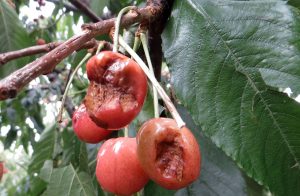
After harvest is finished of sweet and tart cherries, there are usually some fruit left on the tree. When the leftover fruit is unsprayed, it serves as a breeding ground for cherry fruit fly. Egg-laying by adult females actually increases later in the season, even into early October. The fruit that has worms post-harvest serves as a significant source of cherry fruit flies for the following season, even more so than from outside the orchard.
Therefore, a clean up spray within 7 days of harvest can significantly reduce the population.
Commercial growers could use dimethoate, Admire Pro, Delegate, or Altacor (click here for more info).
Residential growers should remove and destroy all fallen fruit (including sweet cherries), and if possible, pick your cherry trees clean to remove egg-laying sites for late-emerging fruit flies. Please play your part in keeping your trees clean of this pest that can devastate a commercial growers’ crop.
Powdery Mildew
After tart cherry harvest, do not let cherry powdery mildew spread. Apply a spray of 1 to 1.5% with your post-harvest fruit fly spray to reduce powdery mildew spores. Repeat in late August (on a cool day).
Peach Twig Borer
second generation egg hatch is underway

In all areas except the warmest locations of Utah, the second generation egg hatch has started or will be starting soon. This generation will last 3 weeks, up to mid-August, with a third generation staring a week later.
Click here for an updated pdf of the spray timing table.
Now is a good time to assess damage from twig borer in your peach trees. Larvae of the first generation feed in succulent shoot tips (not the fruit), so look for shoots where the top 2 to 3 leaves are wilted or dried up (called “shoot strikes”). Only the very top inch of growth or less, will be damaged, so finding the strikes takes a keen eye.
Looking for the damage will help to determine whether or not a treatment is necessary for the second generation. Two shoot strikes per tree is the threshold limit and warrants an application to protect fruit from getting damaged, especially if you are growing early-season peaches.
Peach twig borer is a sporadic pest and usually not a problem on late-season peaches. If you are not seeing any injury on your peaches, you may be able to avoid the sprays for second and third generation egg hatch.
Treatment
Residential growers can use Hi Yield Permethrin, GardenTech Sevin, Spectracide Triazicide, or for organic control, products containing spinosad.
ALL FRUITS
Spider Mites
Spider mites thrive in the hot, dry, and dusty conditions we have experienced in July so far. They can be found on the undersides of leaves, feeding with piercing-sucking mouthparts that removes chlorophyll from the leaves. The resulting symptom is called stippling.
Check for mites by examining the leaves on the lowest branches first. (Mites overwinter in groundcover and migrate up the tree to feed on foliage.) Find and pull off leaves that are stippled, and using a hand lens, look on the undersides of the leaves for the slow-moving mites.
Before deciding on whether to treat, also look for predatory mites within the pest mite population. These are fast moving mites, about the same size, and lighter in color. They can prevent spider mite densities from exceeding economic thresholds. If predators are present, then a treatment may not be necessary. However, if spider mite populations are building, it is important to control them to prevent loss of tree vigor, especially when crop load is high.
Treatment
A 0.5-1% application of horticultural oil is very effective on mites, especially when populations are low, and when the spray coverage is good enough to cover the undersides of the leaves. Repeat on a regular basis or mix the oil with other sprays.
Spider mite options on tree fruits for commercial growers. (Select the crop, and then select “fruit present” stage.)
Cat-facing Damage
Cat-facing injury on fruits is a generic term used to describe a symptom caused by feeding of true bugs (lygus, stink bugs, and others). True bugs feed by inserting their proboscis into the fruit flesh. They excrete a salivary enzyme that breaks down the cells, and then suck up the dissolved food juices. The area of the skin killed by feeding does not grow, and becomes sunken as the rest of the fruit matures, resembling a “cat face.” Although true bugs are considered minor pests, most commercial and residential orchards will see a certain level of damage each year, mostly on peaches.
The fruit damage will look different depending on when the feeding occurred. Severely dimpled fruit indicates that feeding occurred earlier in the season. Early to mid-season feeding will cause strings of oozing gum and sometimes, a water-soaked appearance. Feeding closer to harvest does not cause gumming, and may not be noticeable until later, when the flesh appears brown and corky or even decayed. Sometimes, injury does not show up until fruit is brought out of storage.
Most true bugs overwinter as adults, and they can feed early in the season on very young, developing fruit. They then leave the orchard for other plants (alfalfa, weeds) to breed and feed until later in the season. When alfalfa is cut or weeds die back, true bugs move back to the orchard, with their highest population in the orchards occurring during fruit ripening.
Treatment
- Scout for adults throughout the season to help determine which true bug is most common in your tree or orchard.
- If your orchard is bordered by lots of weedy areas, watch closely for signs of feeding damage on the fruit. By late-August, stink bugs move on to overwintering sites.
- If possible, remove weed hosts in the orchard (mullein, ironweed, horse-weed) or keep them mown within and on orchard edges.
- The most effective products on adult true bugs are the broad spectrum insecticides (carbaryl, synthetic pyrethroids, and the organic, pyrethrin). Only consider a treatment if it is worth the harm of killing beneficial insects that may be feeding on other pests. Often the cost of an application (labor, materials, and loss of beneficials) outweighs the minor fruit losses from stinkbug injury.
PRODUCTION ACTIVITIES
Summer Pruning
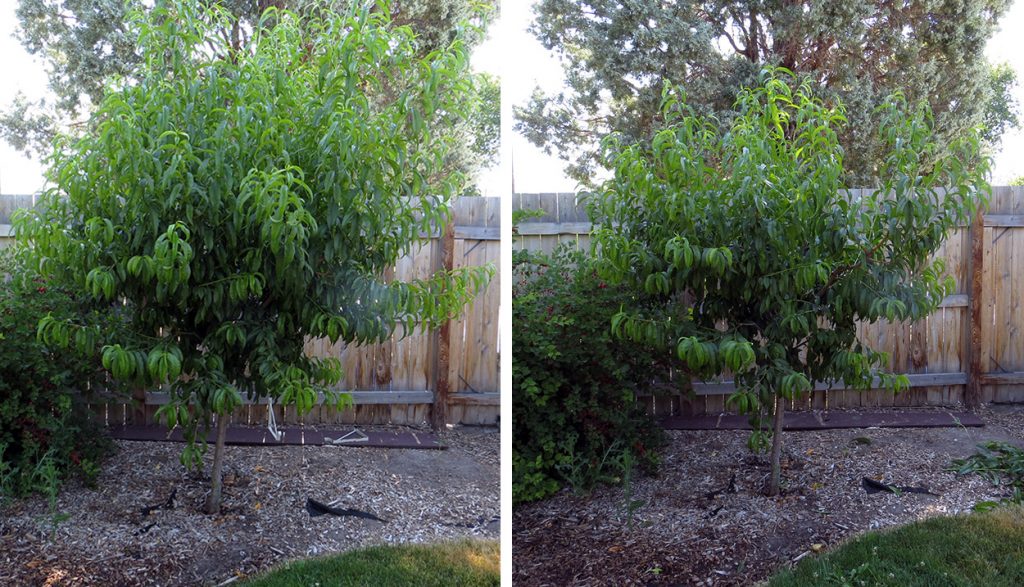
Fruit trees are not normally pruned in summer, but pruning at this time will not harm the tree. The main purpose of summer pruning apples is to selectively remove excess shoot growth to improve light penetration into the tree for fruit color. For peaches, only summer-prune vigorous vegetative shoots that shade the tree interior trees to retain fruiting wood in the interior.
Research has shown that summer pruning of does not affect flowering, fruit set, or shoot growth the following season.
Summer pruning may stimulate new growth, so it should be finished by late July (ideally, early July). Trees that are pruned later in the summer will have delayed leaf senescence and reduced development of cold hardiness in the fall. This is most detrimental for peaches, and could leave trees more susceptible to winter injury or to a disease called cytospora canker.
Nutrient Testing
If you are noticing some symptoms of nutrient deficiency and don’t think it is iron, then now is a good time to collect foliage for nutrient analysis by the USU Analytical Lab. The cost is $65, and the results will be helpful for next year’s nutrient program.
SMALL FRUITS
Rose Stem Girdler
cut any wilting or dried canes to the ground
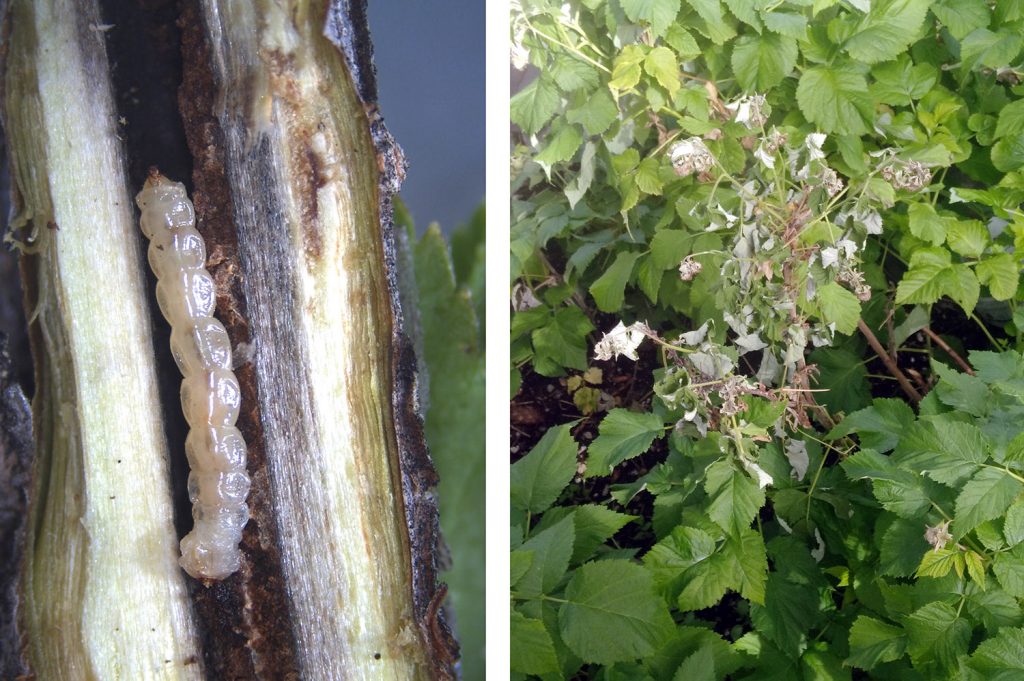
Rose stem girdler can be a serious pest of raspberries. The adult is a shiny, bronze-colored beetle. Adults have just about finished egg-laying, where hatched larvae tunnel into the cane and feed up and down its center. Damage to canes will be visible soon.
Canes may have swellings at the early larval feeding sites, and infested canes may break at weak areas later in the season. Or, the leaves on the entire cane will wilt and turn brown. The best treatment option is to remove and destroy infested canes now and through late in the season. For fall-bearing raspberries, be sure to cut all canes to the ground after harvest to remove any borers inside the canes.
Grape Leafhopper
treat nymphs now

The western grape leafhopper, which is building in numbers now, only feeds on leaves; it does not affect fruit. They damage the plant by extracting sap and chlorophyll, leaving behind white stippled areas. Usually feeding is clustered along veins. As populations increase, foliage may become speckled with dark excrement. But more importantly, they are a nuisance as you work in your grapevines.
The leafhoppers overwinter as adults on weeds or groundcover near grape plants, and lay eggs on foliage in spring. At this time of year, the second generation nymphs are active. Plants can withstand an average of 20 nymphs per leaf.
When leafhopper populations are higher, leaves can turn yellow and drop prematurely. As a result, fruit can become sunburned, resulting in delayed ripening. In addition, small black drops of excrement will mar the appearance of table grapes.
Treatment
- Residential: horticultural oil (1%, only when temperatures are below 85F), insecticidal soap, pyrethrin (Lilly Miller, Pyganic), carbaryl (Bayer Advanced Complete), malathion
- Commercial: acetamiprid (Assail), pyrethrin (Azera, Pyganic, Tersus – good coverage is important), methomyl (Lannate), horticultural oil (1%)
Feeding Damage to Raspberries

We often see blackberry and raspberry fruit with white or tan drupelets, or with shriveled drupelets on the berry. Two common reasons for this are sunscald or insects.
If the discolored drupelets are still firm, the damage is sunscald, occurring only on the exposed side. The fruits are still edible, but not marketable.
If the drupelets are shriveled, then the cause is a chewing or sucking insect.
- Stink bug damage will occur randomly around the berry, and may occur on all sides. As the insect feeds on the berry receptacle, it injures drupelets on either side. When injury is seen, it is often too late for control, since the symptoms don’t show up until several days after the original feeding
- Possible chewing insects include European paper wasp, earwig, or grasshopper.
To determine the insect cause, it often requires investigation, both during the day and at night, for insects on the berries.
- Shake some berries over a cloth to dislodge insects.
- Use a headlamp at night to check for earwigs.
- Check the ground for grasshoppers, and dig in the soil/mulch around the crowns of plants to see if earwigs are hiding during the day.
With ripe fruit, the only insecticide option that would target all of the above-mentioned pests is the insecticide ingredient, pyrethrin. It is organic and has a 0-day PHI. There are many brands, both commercial and residential, with this ingredient.

